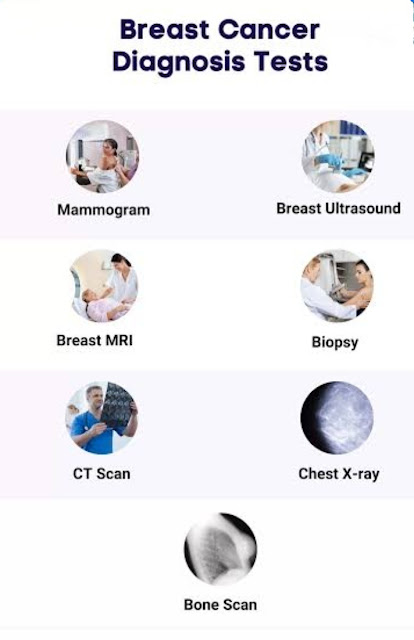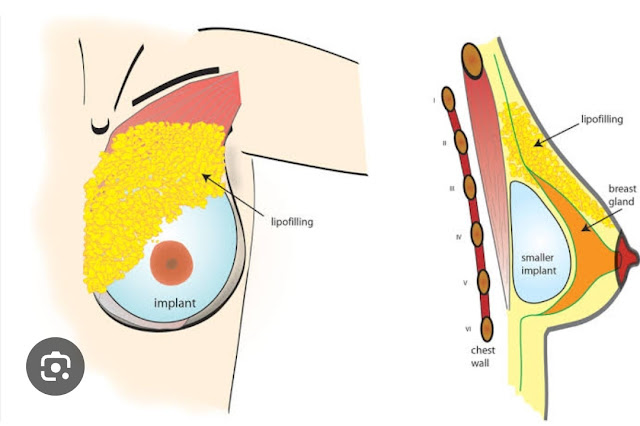BREAST CANCER
Breast cancer is cancer develops in breast cells which may be in lobules or the ducts or fatty tissue or the fibrous connective tissue of the breast. Milk producing glands called as lobules and ducts are the pathways that bring the milk from the glands to the nipple.
TYPES OF BREAST CANCER :-
Noninvasive breast cancer (has not spread from the original tissue)
1.Ductal carcinoma in situ (DCIS): It is a noninvasive type of breast cancer The cancer cells are limited to the ducts in breast and have not attacked the surrounding breast tissue
2.Lobular carcinoma in situ (LCIS): it is also noninvasive cancer, develops in the milk producing glands of breast It has not attacked the surrounding tissue.
Invasive breast cancer (spread from the breast ducts or glands to other parts of the breast).
1.Invasive ductal carcinoma: It is most common invasive type of cancer. This type of breast cancer begins in breast's milk ducts and then invades nearby tissue in the breast. It can begin to spread to nearby organs and tissue also.
2.Invasive lobular carcinoma (ILC): It is a invasive type of cancer, first develops in the breast's lobules and has invaded nearby tissue
Other types of breast cancer
1.Paget disease of the nipple: it is less common type of breast cancer. It begins in the ducts of the nipple, affect the skin and areola of the nipple.
2.Anglosarcoma: This is cancer that grows on the blood vessels or lymph vessels in the breast
3.Inflammatory breast cancer (IBC): It is a rare types of cancer With this condition, cells block the lymph nodes near the breasts, so the lymph vessels in the breast cannot properly drain. Instead of creating a tumor, IBC causes breast to swel look red, and feel very warm. A cancerous breast may appear pitted and thick, like an orange peel.
STAGES OF BREAST CANCER :-
Stage 1. In situ
Stage 2.Axillary lymph nodes
Stage 3. Skin and lymph nodes
Stage 4. Big size distended metastasis to bone (most common)
CLINICAL MANIFESTATIONS
Non tender lesions
Fixed rather than mobile
Hard and irregular borders
Diffuse breast pain
Tenderness with menstruation

Diagnostic Evaluation :-
- History Taking
- Physical examination
- Breast examination
- Mamography
- Breast ultrasound
- MRI and Breast biopsy
MANAGEMENT :-
1.Lumpectomy-removes the tumor and some surrounding tissue, leaving the rest of the breast intact.
2.Mastectomy
a. Modified radical mastectomy the pectoralis major and pectoralis minor muscles are left intact, unlike in radical mastectomy in which the muscles are removed.
(Removal of breast mass+ skin + axillary LN)
b. Radical mastectomy :- ( MRM + Pectoralis muscle)
c. Total mastectomy :- Total mastectomy also involves removal of the breast and nipple areola complex but does not include ALND (Axillary lymph node biopsy).
3.Sentinel lymph node biopsy-removes a few of the lymph nodes that receive drainage from the tumor.
Axillary lymph node dissection-if lymph nodes removed during a sentinel node biopsy contain cancer cells, then may remove additional lymph nodes.
4.Contralateral prophylactic mastectomy-removes healthy breast also to reduce risk of developing breast cancer again.
5.Radiation therapy-used to target and kill cancer cells.
Brachytherapy-place radioactive seeds, or pellets, inside the body near the tumor site. The seeds stay there for a short period of time and work to destroy cancer cells.
6.Chemotherapy is a drug treatment used to destroy cancer cells.
7. Hormon therapy :- Hormone therapy-estrogen and progesterone, two female hormones, can stimulate the growth of breast cancer tumors. Hormone therapy works by blocking production of these hormones, or by blocking the hormone receptors on the cancer cells. This action can help slow and possibly stop the growth of cancer.
8.Targeted therapy - Transtuzumab (Herceptin) is a monoclonal antibody that binds specifically to the HER -2 . It may be given as a single agent or in combination with chemotherapy.
POST OPERATIVE MANAGEMENT :-
- Position :- Semifowlers position with term to affected side.
- Affected side elevated above the heart level
- No IV line placed in affected side hand
- BP measurement should is affected side hand
- Advice for exercise after surgery ex. Wall handclimbing, Rope turning, Rod and broomstick lifting etc.
RECONSTRUCTIVE PROCEDURES AFTER MASTECTOMY :-
1.Tissue expander followed by permanent implant :- The surgeon places a tissue expander (a balloonlike device) through the mastectomy incision underneath the pectoralis y muscle. A small amount of saline is injected through a metal port intraoperatively to partially inflate the expander.
2.Tissue Transfer Procedure :- Autologus reconstruction is the use of the patient's own tissue to create a breast mound. A flap of skin, fat, and muscle with its attached blood supply is rotated to the mastectomy site to create a mound that simulates the breast. Donor sites may include the transverse rectus abdominal myocutaneous (TRAM) flap (abdominal muscle) ,gluteal flap (buttock muscle), or the latissimus dorsi flap (back muscle).
3.Nipple areola reconstruction
4. Prosthetics






















0 Comments